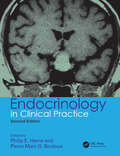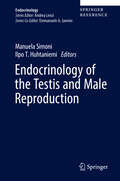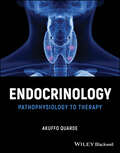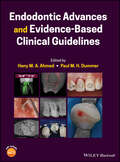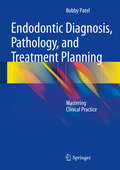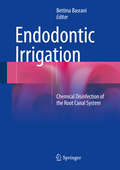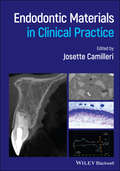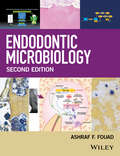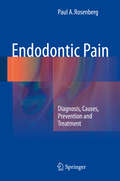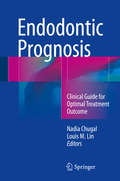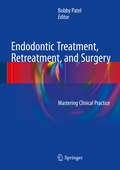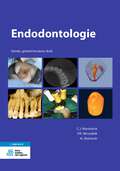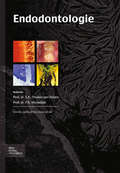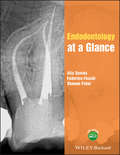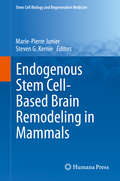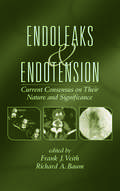- Table View
- List View
Endocrinology and Diabetes: A Problem Oriented Approach
by Francisco Bandeira Hossein Gharib Luiz Griz Manuel FariaDeveloped by a renowned group of international authors, this engaging, case-based title once again offers readers a wide range of thought-provoking case studies that reflect contemporary, challenging, hands-on clinical care. Expanded and fully updated, Endocrinology and Diabetes: A Problem Oriented Approach, 2nd Edition addresses the complete range of endocrinologic problems found in patient care, offering the reader a convenient and pointed way to solve clinical problems in a timely manner. Due to its comprehensive coverage and practical focus, this title has developed a special place in the field of endocrinology and will again be of great interest to endocrinologists, diabetologists, internal medicine physicians, family physicians, fellows, and residents. The enthusiastic reception and warm welcome of the first edition of this book was overwhelming and gratifying. Despite many standard texts that cover physiology and clinical aspects of endocrinology, this book found a special place because it focused on patient care and practical aspects of endocrine practice. In the current volume we were fortunate to again have the honor of collaboration by international authors who pride themselves foremost as clinical endocrinologists. We hope our readers will find this updated, improved edition worthwhile, and use it for the benefit of their patients.
Endocrinology in Clinical Practice
by Philip E. Harris Pierre-Marc G. BoulouxEndocrinology is a complex specialty that spans a wide range of diseases, disorders, and conditions. The field is now moving toward an increasingly personalized approach to patient management, with a greater focus on mechanisms of disease and biomarkers. Written by internationally renowned specialists, the second edition of Endocrinology in Clinica
Endocrinology of Physical Activity and Sport
by Naama Constantini Anthony C. HackneyUnderstanding the influence and interaction between physical activity and the endocrine system are of paramount importance in dealing with a multitude of health problems. In Endocrinology of Physical Activity and Sport, renowned physicians and researchers provide a comprehensive and expanded update on the scientific, clinical and practical components of endocrinology as related to sport and exercise. The authors thoroughly review what is known about how such activity effects the endocrine system and how in turn these hormonal responses affect many other organs and systems of the body. In addition, aspects of endocrinology in non-glandular tissue which have endocrine actions are addressed; for example, adipocytes and the release of leptin and related adipocytokines. Further, a wide range of clinically related topics such as athletic amenorrhea, osteopenia, sarcopenia, and hypogonadism are included. This new edition critically integrates what is known about the complex interaction of the endocrine system in the sports context and will again prove immensely valuable to all physicians and clinical investigators treating those active in sports today.
Endocrinology of Physical Activity and Sport: Second Edition (Contemporary Endocrinology)
by Anthony C. Hackney Naama W. ConstantiniNow in its fully revised and expanded third edition, this comprehensive text represents a compilation of the critical endocrinology topics in the areas of sports medicine, kinesiology and exercise science, written by leading experts in the field. As in previous editions, the focus here is on the critical issues involved in understanding human endocrinology and hormonal workings with regards to physical activity, exercise and sport and how such workings impact the full range of medical conditions, overall health and physiological adaptation. Chapters included discuss the effect of exercise on the HPA axis, the GH-IGF-1 axis, thyroid function, diabetes, and the male and female reproductive systems, among other topics. Additional chapters present the current evidence on circadian endocrine physiology, exercise in older adults, exercise and hormone regulation in weight control, and the effects of overtraining in sports. Chapters brand new to this edition present the role of hormones in muscle hypertrophy, the effect of exercise on hormones in metabolic syndrome patients, how exercise impacts appetite-regulating hormones in clinical populations, and the relative energy deficiency in sport (RED-S) condition.
Endocrinology of Social Relationships
by Peter B. Gray Peter T. EllisonIn social relationships―whether between mates, parents and offspring, or friends―we find much of life’s meaning. But in these relationships, so critical to our well-being, might we also detect the workings, even directives, of biology? This book, a rare melding of human and animal research and theoretical and empirical science, ventures into the most interesting realms of behavioral biology to examine the intimate role of endocrinology in social relationships. <P><P>The importance of hormones to reproductive behavior―from breeding cycles to male sexual display―is well known. What this book considers is the increasing evidence that hormones are just as important to social behavior. Peter Ellison and Peter Gray include the latest findings―both practical and theoretical―on the hormonal component of both casual interactions and fundamental bonds. The contributors, senior scholars and rising scientists whose work is shaping the field, go beyond the proximate mechanics of neuroendocrine physiology to integrate behavioral endocrinology with areas such as reproductive ecology and life history theory. Ranging broadly across taxa, from birds and rodents to primates, the volume pays particular attention to human endocrinology and social relationships, a focus largely missing from most works of behavioral endocrinology.
Endocrinology of the Testis and Male Reproduction
by Ilpo T. Huhtaniemi Manuela SimoniThis book provides a comprehensive overview of endocrinology of the male reproductive system, explaining how it works and how, sometimes, it fails to work. World-class specialists present state of the art knowledge on all aspects, including anatomy, physiology, molecular biology, genetics, pathophysiology, clinical manifestations of testicular diseases, endocrine aspects of andrological and sexual diseases, and therapy. Extensive consideration is given to sexual development, testicular function, the clinical approach to disorders of male reproduction, male hypogonadism, sexual dysfunction, and male infertility. In addition, sociodemographic, psychological, and ethical aspects of male reproductive disorders are discussed. The book is intended as a major reference for endocrinologists, andrologists, and sexologists, as well as basic and clinical scientists. It is published as part of the SpringerReference program, which delivers access to living editions constantly updated through a dynamic peer-review publishing process.
Endocrinology: Pathophysiology to Therapy
by Akuffo QuardeEndocrinology Enables readers to form an integrated understanding of endocrine physiology by examining the mechanisms of action of medical therapies Endocrinology: Pathophysiology to Therapy is a comprehensive resource on medical therapies; in each chapter, the relevant endocrine physiology of the medical therapy is presented, followed by a review of the detailed mechanism of action of selected medical interventions. Where applicable, emphasis is placed on clinical pharmacology pearls, such as side effects and therapeutic monitoring guidelines. Supplementary chapters address additional topics, including immune checkpoint inhibitor-related endocrinopathies, anabolic steroid abuse, pseudo-endocrine conditions, and dynamic tests in clinical endocrinology. Rather than emphasizing guideline-defined treatment protocols, this??book directs attention towards the pathophysiology and fundamental principles of endocrine therapies. Categories of therapies covered in Endocrinology include: Pituitary gland therapies, including Cushing’s disease, Acromegaly, Prolactinoma, adult growth hormone insufficiency, central diabetes insipidus, and syndrome of inappropriate ADH secretion Thyroid gland therapies, including Hashimoto’s thyroiditis, Graves’ Disease, Thyroid Eye Disease, Riedel’s thyroiditis, Thyroid hormone resistance, and RSH secreting tumors Adrenal gland therapies, including primary adrenal insufficiency, primary hyperaldosteronism, classic congenital adrenal hyperplasia, and nonclassic congenital adrenal hyperplasia Pancreatic gland therapies, including diabetes mellitus, neuroendocrine tumors, and hypoglycemia syndromes such as somatostatin analogs and calcium channel blockers Discussing the rationale for using various therapies and enabling readers to appreciate complex concepts in a clinically relevant manner, Endocrinology is an essential reference for practitioners in related fields looking for an accessible and comprehensive resource on the subject.
Endodontic Advances and Evidence-Based Clinical Guidelines
by Hany M. A. Ahmed Paul M. H. DummerExplores recent research and innovations in the field of endodontics and provides evidence-based guidelines for contemporary dental practice Endodontic Advances and Evidence-Based Clinical Guidelines provides a comprehensive and up-to-date description of recent research findings and their impact on clinical practice. Using an innovative approach to the field, the book enables readers to translate the current body of knowledge on endodontic diseases and treatment into guidelines for enhancing patient care. Divided into four parts, the book first addresses new research findings and advances in technology, techniques, materials, and clinical management. In addition, it provides revised clinical guidelines for a variety of areas within the specialty, such as endodontic diagnosis, treatment planning, management of endodontic emergencies, regenerative endodontic procedures, three-dimensional imaging, and the use of systemic antibiotics. Each chapter contains numerous high-quality illustrations and clinical cases highlighting current research directions, key concepts, and new trends in clinical techniques and education. Endodontic Advances and Evidence-Based Clinical Guidelines: Presents the latest understanding of current literature, evidence, and clinical practice Examines new trends, treatments, and advanced diagnostic techniques in the field Covers a wide range of topics, including management of root canals, repair of perforation defects, removal of root filling materials, and alternatives to root canal treatment Endodontic Advances and Evidence-Based Clinical Guidelines is an invaluable resource for undergraduate and postgraduate dental students, general dental practitioners, endodontic specialists, researchers in the field of endodontics, and clinicians, researchers, and educators in other fields of dentistry.
Endodontic Diagnosis, Pathology, and Treatment Planning
by Bobby PatelThis book is intended as a practical guide to endodontic diagnosis, pathology, and treatment planning. The coverage is comprehensive and encompasses such topics as disease classification, the endodontic armamentarium, anatomy, the role of different radiographic techniques, treatment decision making, preoperative management, the use of antibiotics and analgesics, and anesthesia. Numerous high-quality illustrations and clinical photographs are included to highlight key concepts and findings, and best practice is documented by means of clinical case examples. The provision of concise tips and recommendations ensures that the reader will quickly be able to find solutions to diverse endodontic challenges. In addition, the most relevant literature is reviewed in order to support and reinforce the discussed clinical concepts. The book will assist dental practitioners and endodontic trainees/specialists in planning the management of any endodontic case from first principles.
Endodontic Irrigation
by Bettina BasraniThis book reviews the available information on bacterial disinfection in endodontics, with emphasis on the chemical treatment of root canals based on current understanding of the process of irrigation. It describes recent advances in knowledge of the chemistry associated with irrigants and delivery systems, which is of vital importance given that chemical intervention is now considered one of the most important measures in eliminating planktonic microbes and biofilms from the infected tooth. Recommendations are made regarding concentrations, exposure times and optimal sequences. Possible complications related to the use of the different solutions are highlighted, with guidance on response. In addition, clinical protocols are suggested on the basis of both clinical experience and the results of past and ongoing research. Throughout, a practical, clinically oriented approach is adopted that will assist the practitioner in ensuring successful endodontic treatment.
Endodontic Materials in Clinical Practice
by Josette CamilleriEndodontic Materials in Clinical Practice delivers a much-needed comprehensive and clinically oriented reference to the materials used in endodontic practice. It provides complete details on the properties of the materials required for specific techniques in order to help in the selection of the appropriate materials and improve patient outcomes. Comprehensive in scope and filled with helpful illustrations, the book covers endodontic materials used from the pulp to the root-end. In addition, the text considers the location and technique for each of the materials presented. Designed to be a practical and accessible reference, the book is organised by specific clinical procedure. Presents an illustrated guide to all materials used in endodontic practice Focuses on the clinical application for each material Explains why specific materials are used Includes information on how to select the correct material Considers locations and techniques in making material decisions Written for specialist endodontists and residents, dental material specialists, post-graduate students, general dentists, and dentistry students, Endodontic Materials in Clinical Practice is an essential resource for selecting the right materials for specific techniques.
Endodontic Microbiology
by Ashraf F. FouadEndodontic Microbiology, Second Edition presents a comprehensive reference to the microbiology, pathogenesis, management, and healing of endodontic pathosis, emphasizing the importance of biological sciences in understanding and managing endodontic disease and its interaction with systemic health. Provides a major revision to the first book to focus on the problems related to microbes in the root canal and periapical tissues Updates current knowledge in endodontic pathosis, especially regarding next generation sequencing and microbial virulence Presents useful diagrams, images, radiographs, and annotated histological images to illustrate the concepts Emphasizes the importance of biological science in understanding and managing endodontic disease Includes contributions from the leading researchers and educators in the field
Endodontic Pain
by Paul A. RosenbergEndodontic pain is a complex symptom that poses unique challenges for the dentist. This book is a concise, well-structured guide to the assessment and treatment of patients who present with endodontic pain, in which step-by-step descriptions are complemented by informative images and flow charts. The advantages, disadvantages, and significance of specific diagnostic and treatment procedures are clearly described, as is a pharmacotherapeutic approach to the prevention and treatment of pain. In addition, the causes and biological basis of endodontic pain are explained and guidance is provided on further strategies for pain prevention. The crisp narrative, efficient design and visual detail are notable features of this book that will make it an ideal chairside resource for the clinician and a dependable reference for the student.
Endodontic Prognosis
by Nadia Chugal Louis M. LinThis book serves as a clinical guide to help the practitioner improve endodontic treatment outcomes. It focuses on the various factors affecting the prognosis of endodontic treatments and on their impact on short-term and long-term results. The text incorporates up-to-date knowledge, techniques and treatment protocols. Each chapter has been carefully chosen to address either foundational knowledge or a select aspect of endodontic treatment. The authors analyze the knowledge accumulated from a large number of outcome studies and provide the reader with a critical appraisal indicating the strengths and weaknesses of those studies. This information is then used to make recommendations on how to predict the outcome of the intended treatment. The authors emphasize that the endodontic prognosis is a multifactorial phenomenon, underscoring how various factors, singularly and in combination, influence the treatment outcome. Readers are provided with tools to successfully assess the prognosis of the proposed treatment at the outset and to execute the planned treatment focused on optimal outcome.
Endodontic Radiology
by Bettina BasraniEndodontic Radiology, 2nd edition, is a unique reference that examines all aspects of radiographic imaging related to endodontics. Dr. Bettina Basrani and a team of prestigious international contributors build upon traditional radiographic techniques and include the latest information available on digital radiographs and cone beam computed tomography. More than an overview of equipment, the book delves into radiographic interpretation, differential diagnosis, technical difficulties and special circumstances when taking radiographs during the endodontic treatment, and how to choose the correct radiographic technique to obtain the desired images. Chapters explain general radiographic techniques; intraoral techniques; standard radiographs and interpretation; digital radiographs and their manipulation, storage, and interpretation; and CBCT principles, techniques, and clinical considerations.
Endodontic Treatment, Retreatment, and Surgery
by Bobby PatelThis book provides clear, concise guidance on a range of essential treatment strategies for the provision of reliable endodontic care. Practical clinical procedures are described step by step and key concepts emphasized with the aid of a wealth of high-quality illustrations and photographs. Examples of best practice are documented by means of clinical case examples, and the provision of concise tips and recommendations ensures that the reader will quickly be able to find solutions to any one of the myriad of endodontic challenges with which he or she may be confronted. In addition, the most relevant key literature is reviewed in order to support and reinforce the discussed clinical concepts. The described endodontic treatment strategies are all grounded in a sound scientific evidence base. The book should enable practitioners to manage any endodontic case from first principles and will be of value for both dental practitioners and endodontic trainees/specialists.
Endodontologie
by P. R. Wesselink C. J. Warnsinck H. ShemeshDit boek biedt een compleet overzicht van de meest recente ontwikkelingen in de endodontologie. Die ontwikkelingen variëren van nieuwe inzichten en methoden, tot instrumenten, apparaten en materialen. Het is een leerboek én naslagwerk, en is bedoeld voor tandartsen en studenten tandheelkunde. Endodontologie bestaat uit 30 hoofdstukken. Centraal staat steeds het besef dat endodontologie meer inhoudt dan alleen de wortelkanaalbehandeling, en dat nieuwe inzichten voortdurend de behandelkeuze en behandeling beïnvloeden. Na de vorige uitgave (2010) heeft de endodontologie zich verder ontwikkeld. In deze vierde, herziene druk zijn vier nieuwe hoofdstukken toegevoegd: Endodontische epidemiologie, De beslissing tot (her-)behandeling, Autotransplantatie en De klinische toepassingen van CBCT. In deze herziene druk wordt een nieuw onderscheid gemaakt tussen de diagnostiek en behandeling van elementen met een nog (gedeeltelijk) vitale kanaalpulpa en die van elementen met een geheel necrotische pulpa. Ook vitale pulpabehandeling, tandletsel door mechanisch trauma, externe resorpties en differentiële endodontische diagnostiek krijgen hernieuwde aandacht. Door de gedetailleerde inhoudsopgave en index is alle informatie over endodontologie snel terug te vinden. De redactie van deze uitgave bestaat uit prof. dr. P.R. Wesselink, dr. H. Shemesh en C.J. Warnsinck. Auteurs afkomstig van de drie Nederlandse tandheelkunde-opleidingen uit Amsterdam, Groningen en Nijmegen hebben hun bijdrage geleverd met een groot aantal hoofdstukken. Daarnaast hebben diverse auteurs van buiten deze drie opleidingen hun licht laten schijnen op die gebieden waar zij experts in zijn.
Endodontologie: Studenteneditie
by S.K. Thoden Velzen P. R. WesselinkDe endodontologie heeft zich de afgelopen decennia sterk ontwikkeld. Internationaal zijn er nieuwe inzichten, methoden, instrumenten, apparaten en materialen ontstaan. Daarnaast is het aantal onderzoeken en publicaties sterk toegenomen. Essentieel bij deze ontwikkelingen is het besef dat endodontologie meer inhoudt dan alleen de wortelkanaalbehandeling en dat er voortdurend nieuwe inzichten zijn die invloed hebben op de behandelkeuzes. Ook vitale-pulpabehandeling, tandletsel als gevolg van mechanisch trauma, externe resorpties en differentiële diagnostiek vallen eronder.Deze derde druk van Endodontologie geeft een compleet overzicht van de recente ontwikkelingen in het vak. Het boek bestaat uit 26 hoofdstukken die een veelheid aan onderwerpen behandelen, variërend van resorptie tot vitalepulpabehandeling en endodontische aspecten van tandletsel. Afzonderlijke hoofdstukken zijn gewijd aan erosie en niet-odontogene pijn. Bovendien wordt in deze druk een duidelijk onderscheid gemaakt tussen de wortelkanaalbehandeling van elementen met een nog (gedeeltelijk) vitale kanaalpulpa en die van elementen met een geheel necrotische pulpa. Door de gedetailleerde inhoudsopgave en index is alle informatie over endodontologie in een handomdraai terug te vinden.
Endodontology at a Glance (At a Glance (Dentistry))
by Shanon Patel Alix Davies Federico FoschiA practical and colourful introductory guide, Endodontology at a Glance covers all the essential topics (diagnosis, endodontic therapy, pain management and outcome of treatment) as well as the recent developments that comprise the field of endodontology. Written by experts in the field, the book explores the causes and sequelae of endodontic disease and offers suggestions for taking an effective patient history. New addition to the At a Glance series covering a core area of dentistry Review style makes for the ideal revision companion Includes access to a companion website with MCQs for self-assessment and downloadable images for use in teaching
Endogenous Stem Cell-Based Brain Remodeling in Mammals
by Marie-Pierre Junier Steven G. KernieThis text highlights the endogenous regenerative potential of the central nervous system in neonates and juveniles and discusses possible ways it might be manipulated for medical purposes. The first section provides a descriptive summary of the salient steps of human brain development with a discussion of comparisons with other mammalian brains. It also provides a historical perspective on our understanding of ongoing brain development throughout the lifespan and serve to introduce the concept of brain plasticity following injury. The second part is devoted to the endogenous reparative potential of the brain, including its limitations, and articles focusing on defined pathologies (e. g. anoxia/hypoxia, epilepsy, traumatic brain injury and stress) in animal models and in humans pinpoint eventual ways these pathologies might be manipulated. The third and final focuses on the "dark side" of stem cells for brain repair or of the manipulation of spontaneous adaptive events after injury (e. g. genomic instability, sensitization to cancerous transformation and defective neural networks).
Endogenous and Exogenous Regulation and Control of Physiological Systems (Biomedical Engineering Ser. #2)
by Robert B. NorthropFrom a biomedical engineering perspective, this book takes an analytic, quantitative approach to describing the basic components of physiological regulators and control systems (PRCs). In Endogenous and Exogenous Regulation and Control of Physiological Systems, the author provides grounding in the classical methods of designing linear and nonlinear systems. He also offers state-of-the-art material on the potential of PRCs to treat immune system ailments, most notably AIDS and cancer. The book focuses on certain "wet" physiological regulators, such as those using endocrine hormones as parametric control substances. Endogenous and Exogenous Regulation and Control of Physiological Systems includes simulations that illustrate model validations and the putative control of cancer and HIV proliferation. It explores novel, untried immunotherapies on the cutting-edge of PRC treatment and explores the latest technologies.
Endokrine Chirurgie (Springer Reference Medizin)
by Detlef K. Bartsch Katharina HolzerAlle chirurgisch relevanten Erkrankungen der endokrinen Organe sind systematisch mit Schwerpunkten auf dem diagnostischen Vorgehen, der Therapieplanung und -durchführung und dem perioperativen Management beschrieben. Die Darstellung wird zusätzlich durch instruktive Videos veranschaulicht, die mit der MoreMedia-App des Springer-Verlages aufgerufen werden können. Experten aus zahlreichen Zentren im deutschsprachigen Raum haben mit ihrem Wissen zu dem Buch beigetragen.Das Buch ist ein Teil des vierbändigen Werkes "Springer Reference Viszeral- und Allgemeinchirurgie", herausgegeben von M. E. Kreis, D. K. Bartsch und H. Lang. Parallel zur gedruckten Ausgabe erscheint auch eine online-Version des Gesamtwerks, die als Live Reference-Ausgabe kontinuierlich aktualisiert wird.
Endokrinologie und Osteologie in der Hausarztpraxis: Leitfaden für die tägliche Patienten-Versorgung
by Christian WüsterKlinik, Diagnostik, Therapie. Das Buch erfasst alle Erkrankungen der Endokrinologie, die in der Arztpraxis klinisch relevant sind: Erkrankungen der Schilddrüse, Nebenschilddrüsen, Hypophyse, Nebennieren, Gonaden, Pankreas und Diabetes mellitus. Auch alle Erkrankungen der Osteologie werden thematisiert, insbesondere die Osteoporosen, aber auch seltene Osteopathien wie den M. Paget, Phosphatdiabetes oder HPP sowie eine Übersicht zu Knochentumoren. Differentialdiagnostische Überlegungen bei endokrinologischen und osteologischen Symptomen: Alopecien, Müdigkeitssyndrome, Übergewicht, Frakturen. Praktisches Vorgehen bei transidenten Patienten oder bei Patienten mit Kinderwunsch. Mit Algorithmen und Praxistipps. Alles, was häufig und wichtig ist. Für Internisten, Allgemeinmediziner, Gynäkologen, Urologen, Orthopäden, Rheumatologen, Pädiater aber auch Studenten, erfahrene MFAs oder Physiotherapeuten das Praxis-Wissen für die tägliche Versorgung Ihrer Patienten.
Endoleaks and Endotension: Current Consensus on Their Nature and Significance
by Frank J. Veith Richard A. BaumEndoleaks and Endotension is an authoritative resource for vascular surgeons, interventional radiologists and cardiologists, vascular disease specialists, primary care physicians and internists, and students interested in endovascular aneurysm repair. It contains valuable guidelines from a widely respected team of international authorities on the subject.
Endolysosomal Voltage-Dependent Cation Channels (Handbook of Experimental Pharmacology #278)
by Christian Wahl-Schott Martin BielThis book covers the molecular structures and the cellular and in vivo function of endosomes and lysosomes, i.e. intracellular vesicles which are involved in many cellular processes such as endocytosis, intracellular trafficking, degradation of material from inside (e.g. autophagy) and outside the cell as well as exocytosis. Membranes of endolysosomal organelles contain an amazing number and diversity of ion channels. These ion channels are the topic of the present book that focusses on describing the structure, the biophysical properties, physiological functions of endolysosomal ion channels at the molecular, cellular and in vivo level.

